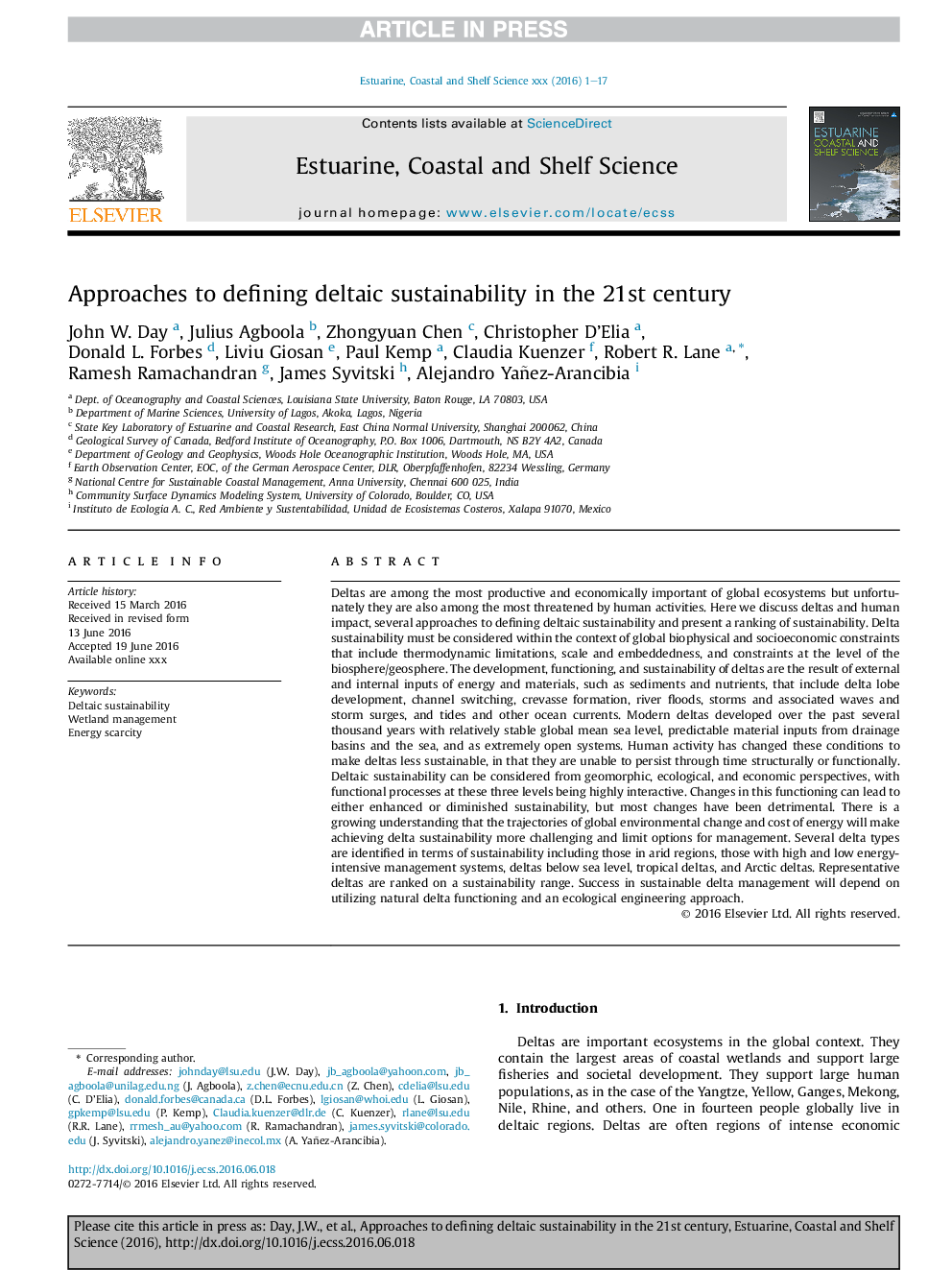| کد مقاله | کد نشریه | سال انتشار | مقاله انگلیسی | نسخه تمام متن |
|---|---|---|---|---|
| 5765370 | 1413069 | 2016 | 17 صفحه PDF | دانلود رایگان |
عنوان انگلیسی مقاله ISI
Approaches to defining deltaic sustainability in the 21st century
ترجمه فارسی عنوان
رویکردها برای تعریف پایداری دلتا در قرن بیست و یکم
دانلود مقاله + سفارش ترجمه
دانلود مقاله ISI انگلیسی
رایگان برای ایرانیان
کلمات کلیدی
پایداری دلتائی، مدیریت تالاب، کمبود انرژی،
ترجمه چکیده
دلتای یکی از مولدترین و مهمترین اقتصادهای اکوسیستم جهانی است اما متأسفانه آنها نیز در معرض خطر ترین فعالیت های انسانی قرار دارند. در اینجا ما درباره دلالت ها و تاثیرات انسانی، چندین روش برای تعریف پایداری دلتا و ارائه رتبه بندی پایداری بحث می کنیم. پایداری دلتا باید در چهارچوب محدودیت های بیوفیزیکی و اجتماعی-اقتصادی جهانی که شامل محدودیت های ترمودینامیکی، مقیاس و تعبیه و محدودیت ها در سطح بیوسفر / ژئوسفر است، مورد توجه قرار گیرد. توسعه، عملکرد و پایداری دلتا ها نتیجه ورودی های داخلی و خارجی انرژی و مواد مانند رسوبات و مواد مغذی می باشد که شامل توسعه لبه دلتا، تغییر سوئیچینگ، تشکیل رسوب، سیلاب رودخانه، طوفان و امواج همراه و بارهای طوفان ، و جزر و مد و دیگر جریان های اقیانوس. دلتای مدرن طی چندین هزار سال گذشته با میانگین نسبتا پایدار جهانی دریا، منابع ورودی قابل پیش بینی از حوضه های زهکشی و دریا و همچنین سیستم های بسیار باز توسعه یافته است. فعالیت های انسانی این شرایط را تغییر داده است تا دلتاها را پایدارتر کند، زیرا آنها قادر نیستند از لحاظ ساختاری یا کارکردی زمان خود را حفظ کنند. پایداری دلتائی را می توان از دیدگاه های ژئومورفیک، زیست محیطی و اقتصادی در نظر گرفت، و فرآیندهای عملکردی در این سه سطح بسیار تعاملی هستند. تغییرات در این عملکرد می تواند منجر به بهبود یا کاهش پایداری شود، اما اغلب تغییرات مضر بوده است. درک فزاینده ای وجود دارد که مسیرهای تغییر محیط زیست جهانی و هزینه انرژی باعث می شود که پایداری دلتا بیشتر شود و گزینه هایی برای مدیریت فراهم شود. چندین نوع دلتا از لحاظ پایداری از جمله مناطقی که در مناطق خشک، کسانی هستند که سیستم های مدیریت انرژی با شدت بالا و کم انرژی دارند، دلالت های زیر سطح دریا، دلتاهای گرمسیری و دلتاهای قطب شمال، شناسایی می شوند. دلتای نماینده در محدوده پایداری قرار دارند. موفقیت در مدیریت دلتا پایدار به استفاده از عملکرد دلتا طبیعی و رویکرد مهندسی محیط زیست بستگی دارد.
موضوعات مرتبط
مهندسی و علوم پایه
علوم زمین و سیارات
زمین شناسی
چکیده انگلیسی
Deltas are among the most productive and economically important of global ecosystems but unfortunately they are also among the most threatened by human activities. Here we discuss deltas and human impact, several approaches to defining deltaic sustainability and present a ranking of sustainability. Delta sustainability must be considered within the context of global biophysical and socioeconomic constraints that include thermodynamic limitations, scale and embeddedness, and constraints at the level of the biosphere/geosphere. The development, functioning, and sustainability of deltas are the result of external and internal inputs of energy and materials, such as sediments and nutrients, that include delta lobe development, channel switching, crevasse formation, river floods, storms and associated waves and storm surges, and tides and other ocean currents. Modern deltas developed over the past several thousand years with relatively stable global mean sea level, predictable material inputs from drainage basins and the sea, and as extremely open systems. Human activity has changed these conditions to make deltas less sustainable, in that they are unable to persist through time structurally or functionally. Deltaic sustainability can be considered from geomorphic, ecological, and economic perspectives, with functional processes at these three levels being highly interactive. Changes in this functioning can lead to either enhanced or diminished sustainability, but most changes have been detrimental. There is a growing understanding that the trajectories of global environmental change and cost of energy will make achieving delta sustainability more challenging and limit options for management. Several delta types are identified in terms of sustainability including those in arid regions, those with high and low energy-intensive management systems, deltas below sea level, tropical deltas, and Arctic deltas. Representative deltas are ranked on a sustainability range. Success in sustainable delta management will depend on utilizing natural delta functioning and an ecological engineering approach.
ناشر
Database: Elsevier - ScienceDirect (ساینس دایرکت)
Journal: Estuarine, Coastal and Shelf Science - Volume 183, Part B, 20 December 2016, Pages 275-291
Journal: Estuarine, Coastal and Shelf Science - Volume 183, Part B, 20 December 2016, Pages 275-291
نویسندگان
John W. Day, Julius Agboola, Zhongyuan Chen, Christopher D'Elia, Donald L. Forbes, Liviu Giosan, Paul Kemp, Claudia Kuenzer, Robert R. Lane, Ramesh Ramachandran, James Syvitski, Alejandro Yañez-Arancibia,
